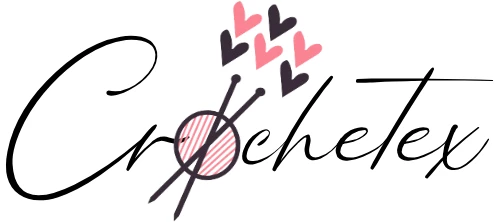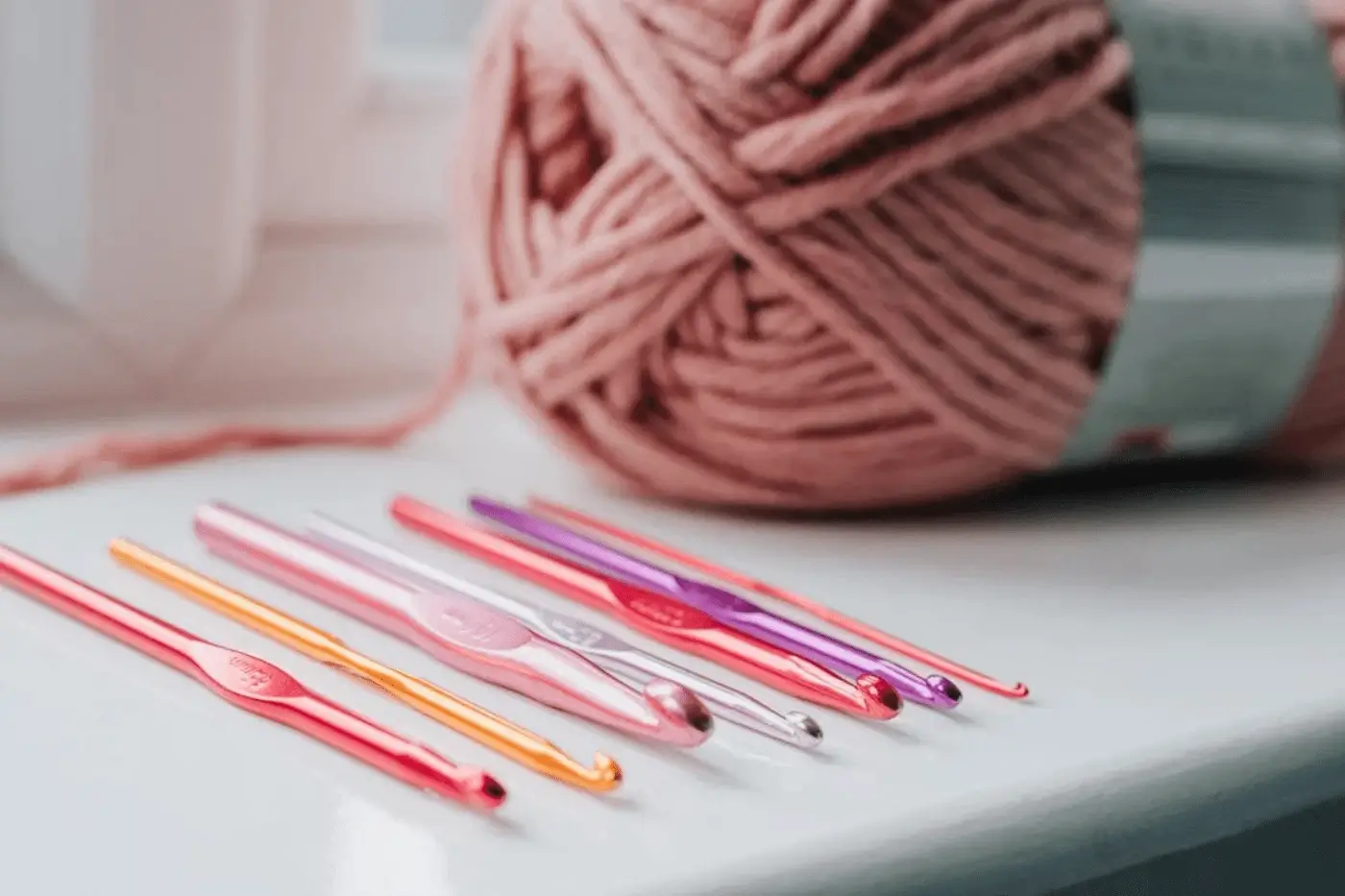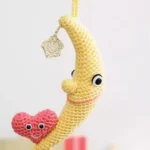Choosing the right crochet hook is essential for a smooth and enjoyable crocheting experience. The type of hook you use can significantly impact your speed, comfort, and stitch definition, making it important to select one that matches your project and personal preferences.
Different crochet hooks vary in material, shape, and size, affecting how the yarn glides and how your hands feel after long hours of crocheting. Some hooks are designed for specific techniques, while others offer ergonomic features to reduce hand strain.
In this guide, we’ll explore the various types of crochet hooks, materials, and sizes, and how to choose the best one for your project. Whether you’re a beginner or an experienced crocheter, understanding crochet hooks will help you improve your technique and enjoy the craft even more!
Table of Contents
- Understanding Crochet Hooks and Their Importance
- Types of Crochet Hooks
- Crochet Hook Materials – Which One Is Best?
- Crochet Hook Sizes and Measurements
- Choosing the Right Crochet Hook for Your Project
- Additional Tools Every Crocheter Needs
- Caring for Your Crochet Hooks
- Conclusion
Understanding Crochet Hooks and Their Importance
Crochet hooks are the most essential tool in crochet, and choosing the right one can make a huge difference in your experience and final project outcome. From stitch consistency to hand comfort, the type of hook you use directly affects how easy or challenging a pattern may be.
What Is a Crochet Hook?
A crochet hook is a tool with a slender shaft and a hooked tip, used to pull yarn through loops to create stitches. It comes in various materials, sizes, and styles, each designed to work with different types of yarn and techniques.
Basic Structure of a Crochet Hook:
- Hook Tip – The curved end is used to catch and pull the yarn through loops.
- Throat – The area just below the hook that helps guide the yarn.
- Shaft – The part of the hook that determines stitch size and gauge.
- Grip/Handle – The section where you hold the hook, sometimes designed ergonomically for comfort.
How Crochet Hooks Interact with Yarn:
- The size of the hook affects the size of stitches—larger hooks create looser stitches, while smaller hooks make tighter ones.
- The hook’s material can change how smoothly the yarn glides—some yarns work better with metal hooks, while others are best with wood or plastic.
By understanding the structure and function of a crochet hook, you can choose the best one for your project, making crocheting easier and more enjoyable.
Why Choosing the Right Hook Matters
Selecting the correct crochet hook is crucial for maintaining tension, ensuring stitch consistency, and preventing discomfort during long crochet sessions.
Impact on Tension and Stitch Consistency:
- Using the wrong hook size can make stitches too tight (difficult to work with) or too loose (leading to gaps in the fabric).
- Matching your hook size with yarn weight ensures your project turns out as intended, especially when following a pattern.
Comfort and Hand Strain – How Ergonomic Hooks Can Help:
- Some crocheters experience hand fatigue, wrist pain, or arthritis when using standard hooks for long periods.
- Ergonomic crochet hooks have cushioned grips or specially designed handles to reduce strain and improve comfort.
Matching Hooks with Yarn Types for the Best Results:
- Smooth metal hooks work best with wool and acrylic yarns for quick stitching.
- Wooden and bamboo hooks provide better grip for slippery fibers like silk or bamboo yarn.
- Plastic hooks are lightweight and great for larger projects with bulky yarns.
By choosing the right hook for your yarn, project, and comfort, you can improve your crochet speed, reduce hand fatigue, and achieve better stitch definition. In the next section, we’ll explore the different types of crochet hooks and their specific uses.
Types of Crochet Hooks
Crochet hooks come in a variety of styles, each designed to suit different crochet techniques, comfort preferences, and project types. Understanding the different types of hooks will help you choose the best one for your needs, whether you’re working on traditional crochet, Tunisian crochet, or need an ergonomic option for comfort.
Standard Crochet Hooks
Standard crochet hooks are the most commonly used type, available in different shapes, sizes, and materials. They are divided into two main styles: inline and tapered, each affecting how the yarn moves through stitches.
- Inline Hooks (Susan Bates Style):
- Feature a deeper, more pronounced hook and a straight throat.
- Provide consistent tension, making stitches more uniform.
- Require more movement when pulling yarn through loops, which some crocheters find beneficial for control.
- Tapered Hooks (Boye Style):
- Have a rounded, less defined hook and a more gradual throat transition.
- Allow yarn to glide smoothly, making stitching faster.
- Offer more flexibility in tension, ideal for looser or more fluid crochet styles.
Differences in Handling and Stitch Formation:
- Inline hooks help maintain even tension and are often preferred by beginners.
- Tapered hooks are great for speed and fluid motion, making them ideal for fast crocheters.
Tunisian (Afghan) Crochet Hooks
Sometimes called Afghan crochet, is a distinctive technique that blends aspects of both knitting and traditional crochet. Tunisian hooks are longer than standard hooks and come in different variations.
What Makes Tunisian Hooks Different?
- Unlike regular crochet hooks, Tunisian hooks hold multiple loops on the shaft at once, similar to knitting needles.
- They can be fixed-length hooks (like knitting needles) or hooks with cables for larger projects.
When and Why to Use Them:
- Tunisian crochet is best for creating thick, textured fabric ideal for blankets, scarves, and sweaters.
- The technique requires special stitches like the Tunisian simple stitch (TSS) and produces a denser, woven-like fabric.
Ergonomic Crochet Hooks
Ergonomic crochet hooks are designed to reduce hand strain and improve comfort, making them ideal for crocheters who experience hand fatigue, arthritis, or carpal tunnel syndrome.
Benefits for Crocheters with Hand Pain or Arthritis:
- Feature soft-grip handles or specially shaped shafts that provide better support.
- Reduce wrist and finger strain, allowing for longer crochet sessions with less discomfort.
- Improve grip stability, especially for those who have trouble holding smaller hooks.
Popular Ergonomic Hook Brands:
✔ Clover Amour – Comfortable soft-grip handles with smooth aluminum hooks.
✔ Furls Odyssey & Streamline – Elegant wooden and resin hooks with ergonomic shaping.
✔ Tulip Etimo – Well-balanced hooks with cushioned grips, great for extended use.
Choosing the Right Crochet Hook for Your Needs
Whether you prefer inline or tapered hooks, Tunisian crochet, or ergonomic designs, selecting the right hook can enhance your crochet experience. Test different types to see what feels most comfortable and works best with your crochet style.
Next, we’ll dive into how different hook materials affect performance and stitch quality.
Crochet Hook Materials – Which One Is Best?
The material of a crochet hook plays a significant role in how smoothly your yarn glides, how comfortable the hook feels, and how durable it is. Different materials work better with certain types of yarn, so choosing the right one can make a big difference in your crocheting experience. Below are the most common crochet hook materials and their benefits.
Metal Hooks (Aluminum & Steel)
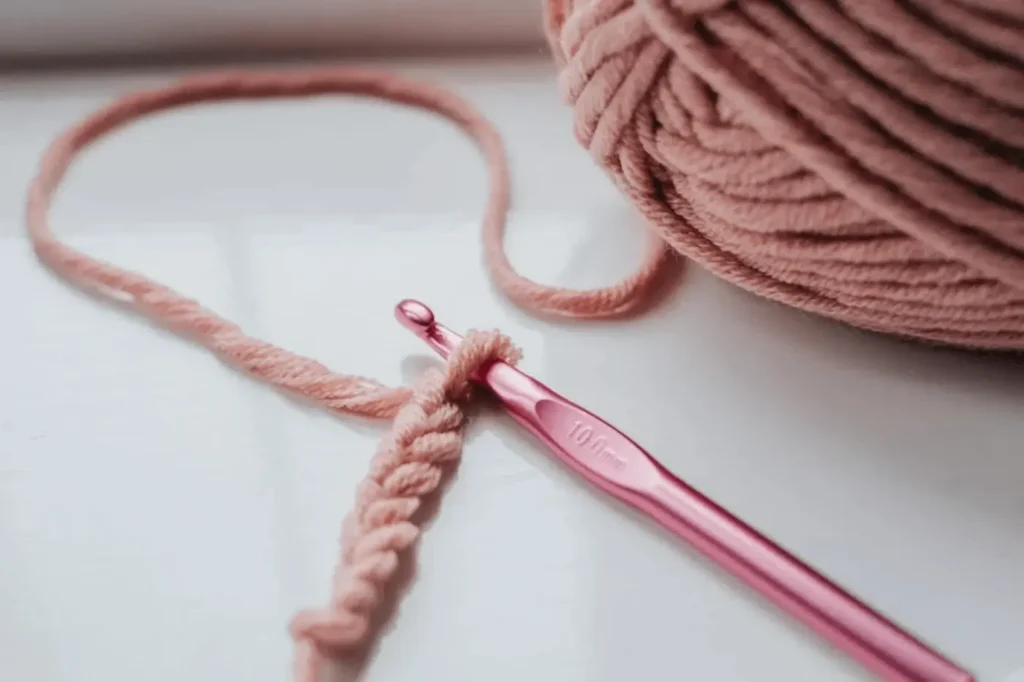
Metal crochet hooks, typically made of aluminum or steel, are among the most popular choices for crocheters due to their smooth surface and durability.
Why Choose Metal Hooks?
✔ Smooth and lightweight – The polished surface allows yarn to glide effortlessly, making crocheting faster and more efficient.
✔ Durable and long-lasting – Metal hooks don’t bend or break easily.
✔ Perfect for tight stitches – Steel hooks, in particular, are great for intricate lacework and fine threads.
Best Suited for:
- Acrylic and wool yarns, as they slide easily on metal surfaces.
- Fast crocheters who prefer quick, effortless movement.
- Intricate projects like doilies, lace, and fine-detail work using thin steel hooks.
Potential Downsides:
- Can feel cold and rigid, which may not be comfortable for all crocheters.
- Some metal hooks lack ergonomic grips, leading to hand fatigue over long periods.
Plastic & Acrylic Hooks
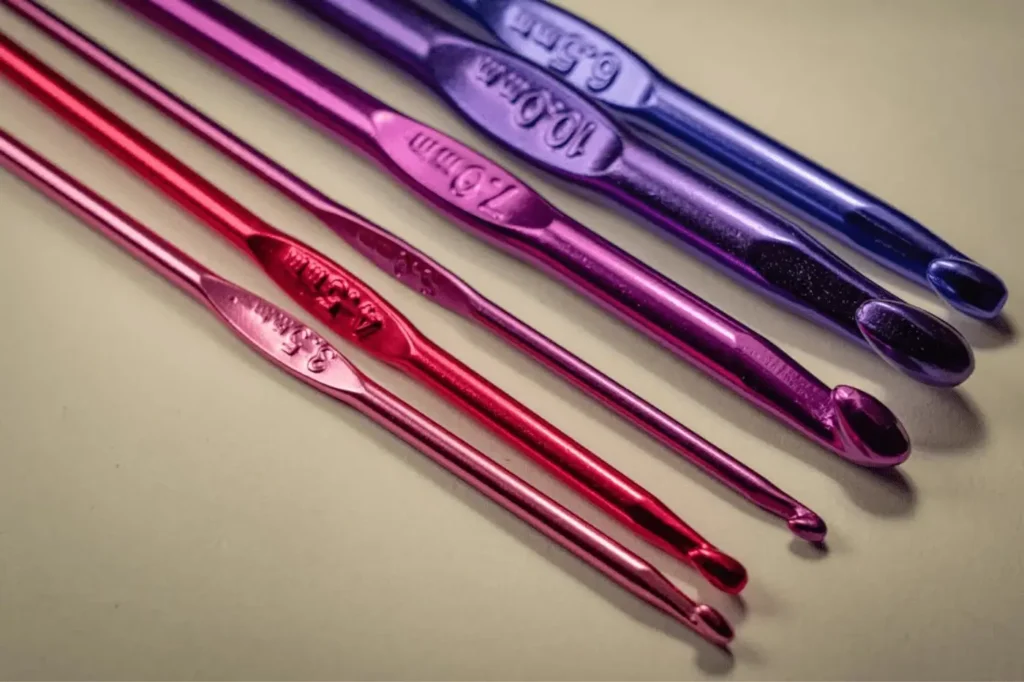
Plastic and acrylic crochet hooks are affordable, lightweight, and widely available, making them a great choice for beginners.
Why Choose Plastic & Acrylic Hooks?
✔ Lightweight and easy to hold – Less strain on hands, making them good for long crochet sessions.
✔ Budget-friendly – One of the most affordable crochet hook options.
✔ Available in large sizes – Perfect for bulky yarns and projects that require oversized stitches.
Best Suited for:
- Beginners, as plastic hooks are inexpensive and easy to handle.
- Bulky and jumbo yarns, since plastic hooks are often available in larger sizes.
- Casual crocheters who don’t need professional-grade tools.
Potential Downsides:
- Less durable – Plastic hooks can bend or break more easily, especially in smaller sizes.
- Not as smooth as metal – Some lower-quality plastic hooks may snag or cause resistance when working with certain yarns.
Bamboo & Wooden Hooks
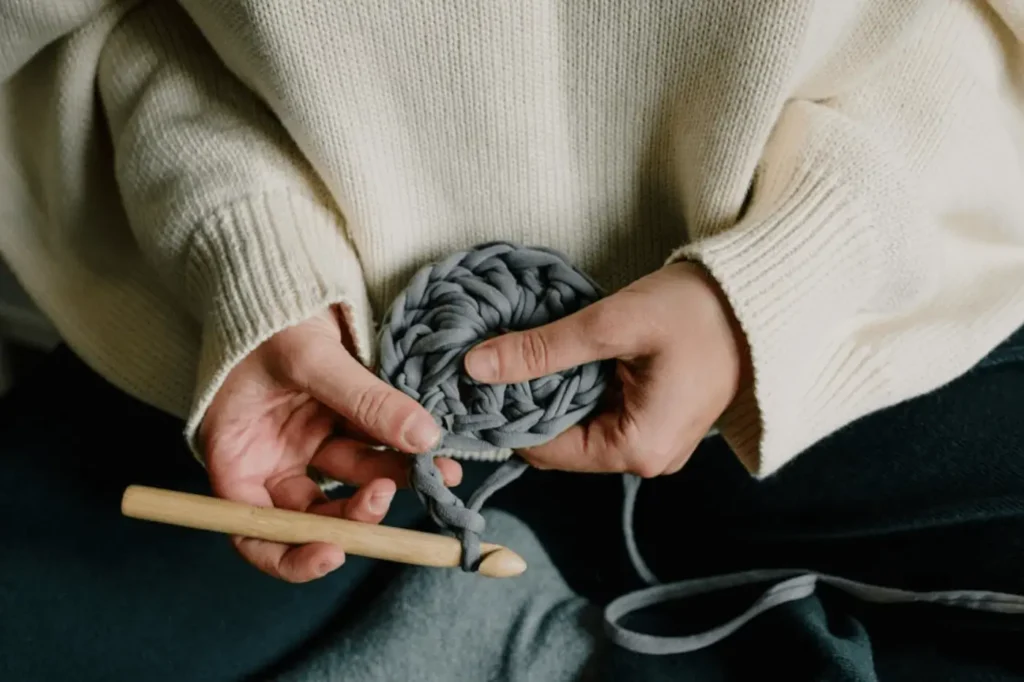
Bamboo and wooden crochet hooks are eco-friendly, warm to the touch, and provide a natural grip, making them an excellent choice for crocheters who prefer a more organic feel.
Why Choose Bamboo & Wooden Hooks?
✔ Best for slippery yarns – The slight grip helps control fibers like silk, bamboo, and mercerized cotton.
✔ Eco-friendly and sustainable – Made from natural materials, making them an environmentally conscious choice.
✔ Warm and comfortable – Unlike metal, they don’t feel cold in hand and provide a softer, more relaxed crocheting experience.
Best Suited for:
- Silk, cotton, and bamboo yarns, which tend to slide too easily on metal hooks.
- Crocheters who prefer a natural feel and lighter weight.
- Projects requiring a gentle grip to maintain control over delicate fibers.
Potential Downsides:
- Less durable – Wooden hooks can wear down or break over time, especially in smaller sizes.
- May not glide as smoothly as metal – Some yarns may have a slight resistance when working with bamboo hooks.
Choosing the Best Crochet Hook Material for You
Each crochet hook material has its own strengths and best-use cases, so your choice will depend on:
✔ The type of yarn you’re working with.
✔ Your crochet speed and style (fast crocheters may prefer metal hooks, while those who need more control might choose bamboo).
✔ Your comfort level, as some materials feel better in hand for longer projects.
By selecting the right hook material for your project, you’ll ensure smoother stitches, better control, and a more enjoyable crochet experience!
Crochet Hook Sizes and Measurements
Crochet hooks come in various sizes, and choosing the right one is essential for achieving the correct stitch size, tension, and overall look of your project. Hook sizes can vary between US, UK, and metric systems, which can sometimes be confusing. Understanding how these systems work and how hook sizes correspond to different yarn weights will help you follow patterns correctly and create well-structured crochet pieces.
Understanding Hook Size Systems
Different countries use different labeling systems for crochet hook sizes, which can sometimes lead to confusion when following international patterns.
- US System: Uses letters and numbers (e.g., G-6, H-8, J-10).
- UK System: Uses numbers only, with higher numbers indicating smaller hooks (e.g., 14 = smallest, 2 = larger).
- Metric System: Uses millimeters (mm) to indicate the diameter of the hook shaft (e.g., 2.0mm, 5.5mm, 10mm).
Importance of Checking Pattern Requirements
- Crochet patterns often specify a hook size in a specific system (US, UK, or metric), so it’s crucial to check which system the pattern is using.
- Some patterns may include a gauge measurement instead of an exact hook size, requiring you to adjust your hook size until you match the gauge.
- When substituting a different hook size, be aware that changing the hook can alter the final size of your project.
Tip: Always use a conversion chart or check the yarn label to find the correct hook size for your project.
Matching Hook Sizes with Yarn Weights
Each yarn weight category has a recommended crochet hook size range to ensure the best stitch definition, fabric flexibility, and ease of crocheting.
| Yarn Weight | Recommended Hook Size (mm) | Best Use Cases |
|---|---|---|
| Lace (1ply, 2ply) | 1.5mm – 2.5mm | Doilies, lacework, fine shawls |
| Lightweight (4ply, Fingering, Sport) | 2.5mm – 3.5mm | Baby clothes, motifs, delicate garments |
| DK (Double Knitting) | 3.5mm – 4.5mm | Sweaters, scarves, accessories |
| Aran/Worsted | 5.0mm – 6.5mm | Hats, blankets, home décor |
| Chunky/Bulky | 6.5mm – 9.0mm | Thick blankets, warm garments |
| Super Chunky/Jumbo | 10mm+ | Oversized scarves, rugs, quick projects |
How Hook Size Affects Stitch Definition and Tension
- Smaller hooks (2mm-4mm): Create tight, compact stitches, great for amigurumi, lacework, and detailed projects.
- Medium hooks (4.5mm-6mm): Produce balanced stitches, ideal for garments and blankets.
- Larger hooks (6.5mm+): Make loose, airy stitches, perfect for chunky scarves, home décor, and quick projects.
If your stitches look too tight, switch to a larger hook. If they appear too loose, try a smaller hook to achieve the correct tension.
Conversion Chart for Crochet Hook Sizes
Since crochet hook sizes differ across US, UK, and metric systems, a conversion chart can help ensure you’re using the correct hook.
| Metric (mm) | US Size | UK Size |
|---|---|---|
| 2.0mm | B-1 | 14 |
| 2.5mm | C-2 | 12 |
| 3.0mm | D-3 | 11 |
| 3.5mm | E-4 | 9 |
| 4.0mm | G-6 | 8 |
| 4.5mm | 7 | 7 |
| 5.0mm | H-8 | 6 |
| 5.5mm | I-9 | 5 |
| 6.0mm | J-10 | 4 |
| 6.5mm | K-10.5 | 3 |
| 7.0mm | – | 2 |
| 8.0mm | L-11 | 0 |
| 9.0mm | M/N-13 | 00 |
| 10.0mm+ | P/Q | – |
Tip: Always check the pattern and yarn label to confirm the correct hook size, especially when working with international patterns.
By understanding crochet hook sizes, matching them with the right yarn weight, and using a conversion chart, you can ensure better stitch consistency, correct tension, and an overall smoother crochet experience.
Choosing the Right Crochet Hook for Your Project
Selecting the right crochet hook for your project is just as important as choosing the right yarn. The size, material, and style of the hook can impact your stitching speed, fabric texture, and overall comfort while crocheting. Whether you’re a beginner or working on a specialized project like amigurumi or lacework, understanding which hook to use will help you achieve the best results.
Best Crochet Hooks for Beginners
If you’re just starting out, choosing the right hook can make learning easier and more enjoyable. Here are some key features to look for:
- Medium size (4mm – 5.5mm) – Easy to handle and works well with common yarn weights (like DK or worsted).
- Smooth finish – Ensures the yarn glides effortlessly, preventing snags.
- Ergonomic grip – Reduces hand fatigue, making it easier to practice for long periods.
Top Beginner-Friendly Brands:
✔ Clover Amour – Comfortable soft-grip handles, great for beginners.
✔ Susan Bates Silvalume – Affordable aluminum hooks with a smooth finish.
✔ Boye Crochet Hooks – Popular tapered hooks that work well for general projects.
Starting with a medium-weight yarn (like acrylic or wool) a 5mm hook is ideal for learning basic stitches and maintaining good tension.
Best Hooks for Different Crochet Styles
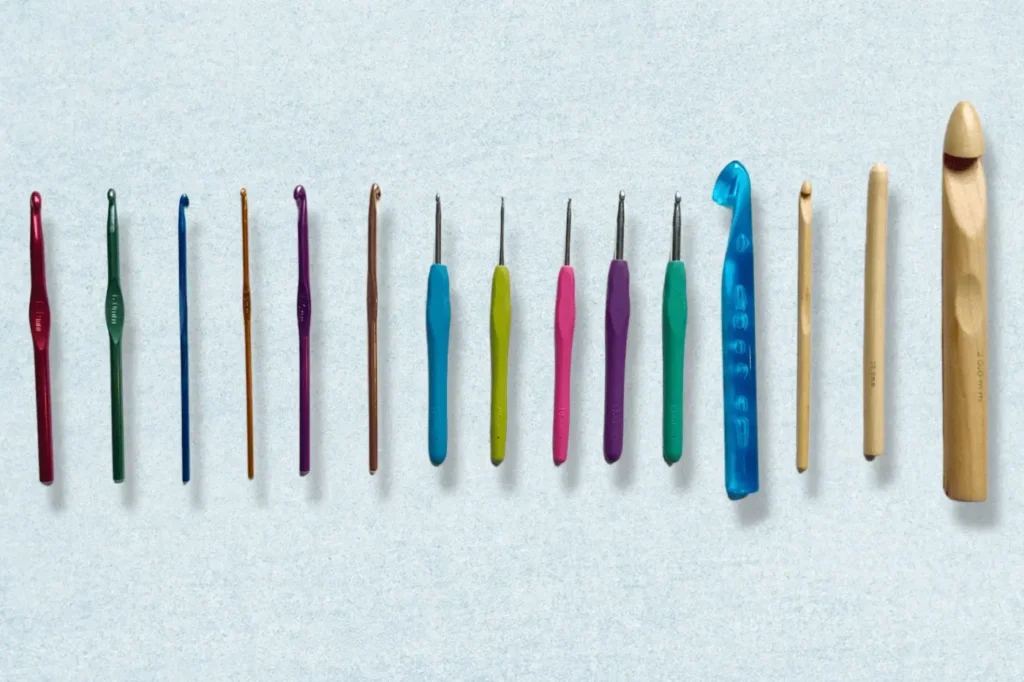
Different crochet techniques require specific hooks to achieve the best results. Here’s how to match your hook to your project:
- Amigurumi (Smaller Hooks for Tight Stitches)
- Small hook sizes (2mm – 3.5mm) create tight stitches that hold stuffing in place.
- Inline hooks (like Susan Bates) help maintain consistent tension.
- Lacework (Thin Steel Hooks)
- Steel hooks (0.5mm – 2mm) are perfect for fine, intricate crochet patterns.
- Ideal for doilies, lace shawls, and thread-based projects.
- Blankets and Garments (Larger Hooks for Looser Stitches)
- Larger hooks (6mm – 12mm) create soft, airy stitches that drape well.
- Great for chunky blankets, oversized sweaters, and quick projects.
Choosing the right hook ensures your stitches hold their shape, your tension stays consistent, and your fabric feels comfortable and well-structured.
Signs You’re Using the Wrong Hook Size
If your crochet project doesn’t look or feel right, you might be using the wrong hook size. Here are some common signs:
- Loose Stitches and Gaps:
- The fabric seems too open and lacks structure.
- This happens when the hook is too large for the yarn weight.
- Stiff, Overly Tight Fabric:
- Hard to insert the hook into stitches.
- The fabric feels rigid and lacks flexibility, meaning the hook is too small.
- Hand Strain and Discomfort:
- If your hand cramps or feels sore after crocheting, your hook may be too small or poorly designed.
- Using an ergonomic hook can help prevent hand fatigue.
Tip: Always check your pattern’s recommended hook size and make a gauge swatch before starting large projects to ensure the best fit.
By choosing the right crochet hook for your skill level and project type, you’ll achieve better stitch consistency, improved comfort, and a more enjoyable crocheting experience!
Additional Tools Every Crocheter Needs
While crochet hooks and yarn are the essentials, having the right tools can make crocheting easier, more efficient, and more enjoyable. Stitch markers, yarn needles, measuring tapes, and other accessories help improve precision and organization, ensuring that your projects turn out exactly as planned.
Stitch Markers and Row Counters
Keeping track of stitches and rows is essential for maintaining accuracy, especially in complex patterns.
- Stitch Markers:
- Used to mark the beginning of a round in circular crochet.
- Helpful for keeping track of stitch increases or decreases.
- Available in locking, split-ring, and clip-on styles.
- Row Counters:
- Help track the number of rows in a pattern.
- Essential for projects with repetitive stitch patterns or shaping.
- Can be digital, manual, or even a simple notebook tally.
Using stitch markers and row counters prevents mistakes, saving time and effort when working on detailed projects.
Yarn Needles and Scissors
Proper finishing touches are just as important as the stitches themselves, making yarn needles and scissors must-have tools.
- Yarn Needles (Tapestry Needles):
- Used for weaving in ends to give projects a neat, polished look.
- Have a large eye to accommodate thick yarns.
- Available in plastic, metal, and bent-tip designs.
- Scissors or Thread Cutters:
- Sharp, small scissors are best for precise cutting.
- Some crocheters prefer yarn snips or thread cutters for quick trimming.
- Keeping scissors handy ensures clean and professional-looking finishes.
Tip: Always weave in ends securely to prevent unraveling, especially in wearable items and home décor projects.
Measuring Tapes and Gauge Tools
Achieving the correct size and fit in crochet requires accurate measuring tools.
- Measuring Tapes:
- Used to measure finished dimensions for garments, blankets, and accessories.
- Flexible and easily wraps around curved pieces like hats and sleeves.
- Available in retractable or standard styles.
- Gauge Tools:
- Help check stitch size before committing to a full project.
- A gauge swatch ensures that your final item will match the pattern’s intended size.
- Avoids issues like too-tight or too-loose stitches that can affect fit.
Tip: Always measure gauge before starting sweaters, fitted garments, or intricate patterns to avoid surprises later.
Having these additional crochet tools improves efficiency, enhances precision, and makes projects more enjoyable. Whether you’re a beginner or an experienced crocheter, investing in the right accessories will help you crochet with ease and confidence!
Caring for Your Crochet Hooks
Taking good care of your crochet hooks ensures they last longer, remain comfortable to use, and perform at their best. Proper storage, cleaning, and knowing when to replace old hooks can make a big difference in your crocheting experience.
Proper Storage to Prevent Damage
Keeping your crochet hooks organized and protected helps prevent loss, bending, or breakage.
- Hook Cases and Organizers:
- Fabric pouches, zippered cases, and roll-up organizers keep hooks secure and easy to access.
- Some cases have individual slots for different hook sizes, preventing them from getting scratched or tangled.
- Storage Tips:
- Store hooks in a dry, cool place to avoid rusting (for metal hooks) or warping (for wooden hooks).
- Avoid tossing hooks loose in a bag or drawer, as they can get damaged or lost.
Tip: A dedicated crochet organizer keeps all your tools in one place, making it easier to find the right hook when needed.
Cleaning Different Hook Materials
Regular cleaning keeps crochet hooks smooth and free from dust, oil, and residue, ensuring that yarn glides effortlessly.
- Wiping Down Metal and Acrylic Hooks:
- Use a soft cloth or microfiber towel to remove dust and debris.
- For deeper cleaning, wipe with a damp cloth and mild soap, then dry thoroughly to prevent rusting.
- Conditioning Wooden Hooks to Prevent Drying Out:
- Wooden and bamboo hooks can dry out and splinter over time.
- Apply a small amount of natural oil (such as coconut or mineral oil) to keep them smooth.
- Avoid exposing wooden hooks to excess moisture or extreme heat, as they may warp.
Tip: Clean hooks every few weeks, especially if you use them frequently, to maintain their smooth finish and ensure an enjoyable crocheting experience.
When to Replace Old or Worn-Out Hooks
Even the best crochet hooks don’t last forever. Knowing when to replace a hook can help maintain consistent stitch quality and prevent hand strain.
- Signs of Wear:
- Rough or chipped edges that snag yarn.
- Bent or warped hooks that affect stitch formation.
- Loose grips or peeling coatings on ergonomic hooks.
- When to Invest in New Hooks:
- If a hook is causing frustration, discomfort, or uneven stitches, it’s time to upgrade.
- Consider trying ergonomic hooks if you experience hand pain or fatigue.
- If switching yarn types, you may need to invest in different materials (e.g., wooden hooks for slippery yarns).
Tip: Keeping a few extra hooks on hand prevents interruptions when a favorite hook wears out or goes missing.
By storing, cleaning, and replacing hooks when necessary, you’ll keep your crochet tools in top condition, ensuring a smooth, enjoyable, and hassle-free crocheting experience!
Conclusion
Choosing the right crochet hook is essential for achieving consistent stitches, comfortable crocheting, and successful projects. Understanding hook types, materials, sizes, and how they interact with different yarns can help you make informed decisions that improve your crochet experience.
Don’t be afraid to experiment with different hooks—what works for one person may not work for another. Try different styles, materials, and sizes to find the hook that feels best in your hands and suits your project needs.
Building a well-rounded crochet toolkit with the right hooks and essential tools will make your crocheting more enjoyable, efficient, and comfortable. With the right hook in hand, you’ll be ready to create beautiful, high-quality crochet projects with ease! Happy crocheting! 🧶✨
